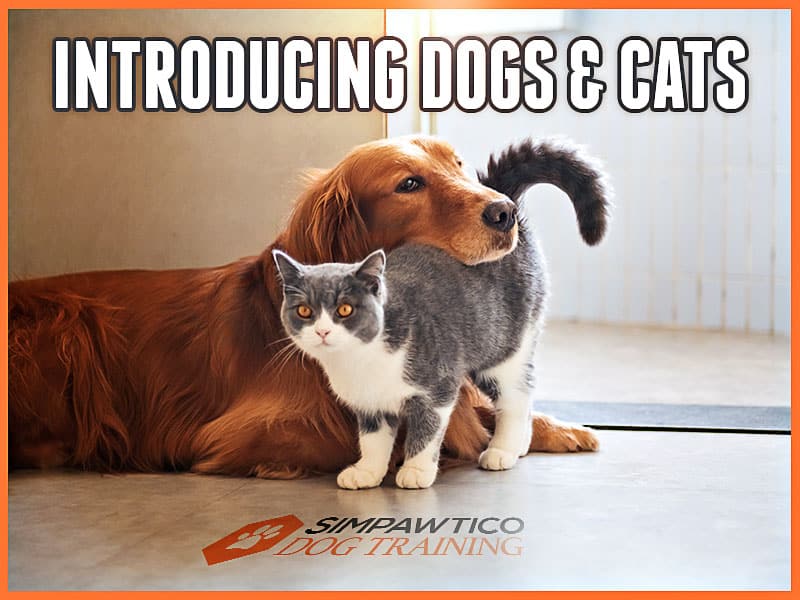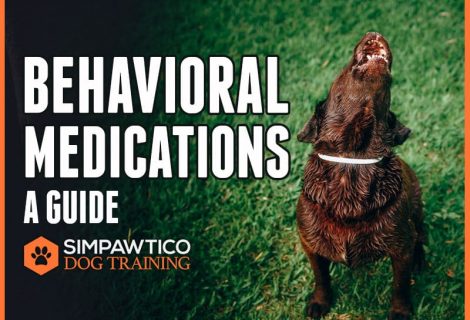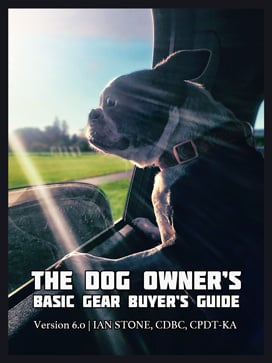How to Introduce Your New Dog To Your Cat (or Vice Versa)
Many people encounter problems with their existing pets when bringing home a new one. For example, if you have a dog or dogs and bring home a cat (or vice-versa), some stress and friction are expected. This article will help you formulate a plan to get some headway with the problem.
FULL DISCLOSURE: ultimately, there’s no guarantee that your cat and dog will ever become friends. Patience and management are the best tools until you have a feel for how things will go.
Download+Print this article as a PDF!
Start ’em young, if possible: Kittens and puppies usually adjust to other species more readily than adult cats and dogs. Animals that are socialized with other species when they are young are much more likely to be friendly to them as adults. Likewise, adult cats or dogs that grew up with the opposite species are likely to do well. So naturally, calm, socialized adults are more straightforward to introduce than young, energetic adolescents.
PRE-FLIGHT CHECK
Set up a Safe Room: Create a special “Fortress of Solitude” for your cat where the dog is never allowed to go. This could be a spare bedroom, utility room, walk-in closet, etc. You could use even one whole level of your house this way. Use cat doors, gates, or doors wedged open with just enough space for the cat to go through but not the dog. Get your cat used to being in this space alone. Put your cat’s food, water, bed, and litterbox in the Safe Room. Try to keep the litterbox away from other items.
Feline Bug Out Plans: Have high places for your cat in other rooms. Your cat can jump up on these things, but the dog won’t be able to: cat towers, high shelves with cat-friendly access, etc. Being high helps cats feel safe and keeps them out of reach of (most) dogs.
Have a Way to Contain Your Dog: You must ensure you’ve got a suitable crate or a room with a door or gate. If your new dog is not crate trained or suffers from isolation distress/anxiety, you will have a tough time with this. Please consider all of the moving parts you’ll have to manage. Do you have the time and resources to devote to this?
THINGS TO KNOW GOING IN
- Your first concern should be your cat. Though they can defend themselves to some degree, cats are more vulnerable and the least social of the two.
- Cats can hurt dogs badly with their claws, but on the same token, dogs are much stronger and can hurt or kills cats much easier.
- Cats are often territorial and must be slowly introduced to “intruders.”
- Cats do not like their routines upset and may express their frustration by not using their litterbox. It’s not the end of the world if this happens and can be remedied.
- The quick movements of cats running and jumping often trigger the predatory sequence in dogs.
- Dogs can be quirky about it; they can be fine with a familiar cat and still attack a new cat. They can also be all right with a cat in the house and still attack the same cat outside.
- Most dogs can learn the difference between squirrels and cats (i.e., chase the squirrels, but not the cat).
- A noisy, excited dog may just want to play but may still accidentally hurt a cat.
- Always avoid any form of punishment or correction for unwanted behavior. This will only make your pets associate unpleasant experiences with each other. This is called a “Superstitious Association,” and it’s very hard to undo.
OKAY, SO WHAT DO WE DO ABOUT IT?
Intensity Before Frequency: As with any behavior, in the correct progression, you will see a reduction in intensity before a decrease in frequency. This concept is a training Master Key. Fixation on the cat progressively gets less intense and prolonged before the number of actual incidents diminishes.
Get Well-Acquainted with Cat and Dog Body Language: get a thorough understanding of what your pets will do to communicate different states to other animals. Dog and cat body language is different. We recommend picking up a book or at the very least, looking at Lili Chin’s infographics.
In the meantime, here are some quick things to look for:
|
Cat signs of stress
|
Dog signs of arousal and/or prey behavior
|
Get Your Feedback System Straightened Out: As we’ve said multiple times throughout Simpawtico material, feedback is a key component to having a dog. More often than not, though, owners’ feedback is weak. Without going into a full lesson on feedback, markers, and all of that, some of the main ideas are:
- Don’t take any good behavior for granted, especially something you got for free. Praise and reward all good behavior. Praise and reward engagement and focus.
- Mistakes are an opportunity to try again. If they were bad 3 seconds ago but are good now, TELL THEM! Analog, and representative feedback is critical.
- If you don’t have a consistent communication system with your dog, get on it before you tackle any of this. We use a marker system consisting of “Yes,” “Good,” and “Nope.”
For more info, read our article on using feedback.
Impulse Control: Any work you do with impulse control always translates to good character traits all around. It works kind of like a muscle, so it has to be trained, exercised, and kept toned. Usually, the most effective way to begin working on it is with:
- Waits and Stays at barriers and thresholds—build duration and ratchet up distractions
- Take It, Leave It—Take It and Leave It are easy to get good at quickly. We have a video post for that.
- Drop It is best taught with Tug, an instructive, multi-use activity all by itself.
- Good, polite leash walking is labor intensive but well worth the time spent on it. Take a look at our Loose Leash Walking course for a complete program to cinch this one down.
Classical Conditioning: It is important not simply to address what your dog or cat does; that’s treating symptoms, not the cure. It’s almost more important to address internal motivations, which is what drives behavior in the first place.
We’ve written extensively about how to use Classical Conditioning so you can learn more.
PHEROMONES
New research done by the University of Lincoln in the UK suggests that pheromone products indeed have a beneficial effect on cat-dog interactions in homes where tension may be present. The results show that both products used—Feliway Friends™, which emits pheromones that are calming for cats, and Adaptil™, which does the same for dogs —positively impacted cat/dog interactions in the home.
The results also showed that Adaptil was more effective than the Feliway Friends, even though the comfortability of the cat seems to have a stronger influence on the quality of the cat-dog relationship. It could therefore be seen as surprising that it was the product releasing dog pheromones that were seen to increase “desirable interactions.” Researchers suggested that possibly dogs’ behavior is “the primary determinant of the cat’s quality of interaction with it” (Prior, 2020).
BRINGING YOUR NEW DOG HOME (and making sure your cat doesn’t riot)
PHASE ONE—ENVIRONMENTAL HABITUATION
- Have your cat in their Safe Room.
- Exercise your new dog outside, preferably in their new yard if there is a fenced space.
- Sniff-n-stroll to explore the boundaries of the yard on a leash.
- Hand-feed your dog some food.
- Bring your dog inside on a leash and let them sniff the main living area; focus on where the cat has been.
- Make good observations of your dog’s body language and reactions as they experience the cat’s smell.
- Put the dog in their crate or room with a chew toy (providing they’ve been both crate-trained and chew toy trained).
- Let your cat come out and smell the room from which the dog has just been removed.
- Make good observations of your cat’s body language and reactions as they experience the dog’s smell.
- Keep your cat and dog in separate rooms for at least a week. When your dog is out, your cat is in the Safe Room. Your cat can be loose in the house when your dog is crated or outside. Don’t worry if it takes your cat some time to come out of their Safe Room; they’ll do it when they’re ready. Have some kind of cue that tells your cat it’s safe to come out. A gate works very well for this. When the gate is down, for example, the coast is clear. ONLY REMOVE IT WHEN THE DOG IS CONTAINED OR OUT OF THE HOUSE. This cue has to be absolutely reliable for your cat, or they will never know when it’s safe to come out.
PHASE TWO—PROTECTED SOCIALIZATION
- Let your dog and cat see each other with a barrier. Either have a gate up or have your dog in their crate. Begin Classical Conditioning for both. Don’t encourage interaction if they are not interested.
- Strive for at least two layers of protection: leash, barrier, or even a basket muzzle for the dog if necessary.
- Don’t force interactions.
- Do not put the cat in a crate and let the dog explore around it. This can be extremely stressful for the cat because there’s no escape route for them. Cats need to feel like they can get away.
- Monitor and adjust the work according to how they’re doing.
PHASE THREE—DEEPER SOCIALIZATION
- Have your dog on a leash and your cat loose in the room. Begin Classical Conditioning, emphasizing calm behavior.
- If either animal wants to retreat, make sure they can. Praise your dog for choosing to engage with you rather than your cat, or at least to otherwise not fixate on your cat.
- If one animal is friendly, but the other is not, do not allow them to interact. If your cat is friendly but you are not sure about the dog, consider a muzzle for first interactions. This must be pre-trained before just slapping it on (consult a trainer for this).
PHASE FOUR (If your cat is allowed outside)
- Have your dog on a leash with your cat outside. Continue Classical Conditioning, emphasizing calm/friendly behavior.
PHASE FIVE—SHOWTIME!
- Test steps two and three without food.
- Allow both animals loose in the house together with supervision. Be ready to intervene if necessary calmly.
HOUSTON, WE HAVE A PROBLEM
If you’re struggling with the cat/dog peace negotiations in your house, it’s probably time to involve a professional to help you execute some of these plans. Find a trainer or (preferably) a behaviorist or certified behavioral consultant in your area to work more closely with you on this! Good luck!
ADDITIONAL RESOURCES
Below are affiliate links. These won’t cost you anything, but the commissions we may earn through them help offset the cost of dog treats. Read our disclosure policy, and thanks for your support!
- Be proactive! A well-socialized dog is immensely easier to habituate to a new pet in the house. Take a look at our socialization article for more.
- Canine body language is an endless area of study. It’s so granular that it can take years to get to where you’re savvy with even just the majority of it. That’s a lot for owners to digest so here’s an article from the Whole Dog Journal that will give you a good primer on it with some of the most common things to look for beyond the short list I listed above.
- Buy Adaptil Buy Feliway
- If you’re interested in the research, here’s an article on that study by the University of Lincoln.










HY
Huskies can exhibit cat-like behaviors, sharing traits such as curiosity, playful antics, grooming habits, and independence. Understanding these similarities enhances the bond between owners and their unique furry companions.
If you approve my comment I shall be Thankful to you for this goodwill,
Thank You